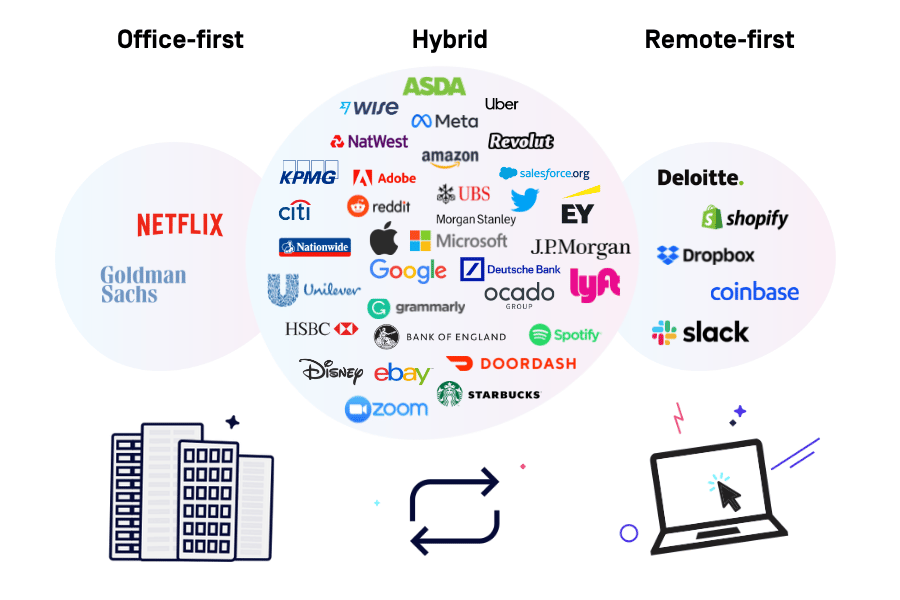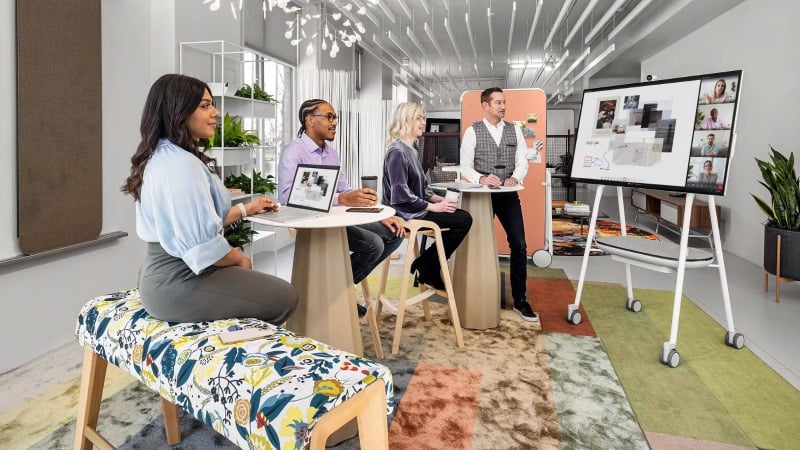It's hard to believe it's already been a year since most Covid restrictions were lifted in the UK. But have workers returned to the office? Have we returned to the pre-pandemic normal or forged a new path forward?
The answer depends on who you ask. Some workers have eagerly returned to the office, while others have grown fond of the freedom and flexibility of remote work. Some employers have demanded people return to the office full-time, while others have adopted a hybrid or remote-first approach.
We explore the pros and cons of returning to the office and the strategies the world's biggest companies are taking.
To return or not to return?
The decision of whether to return to the office is a complex one. It depends on many factors, including the nature of the work, the preferences and needs of individual employees, and the overall culture and goals of the organisation.
One of the potential benefits of returning to the office is more opportunities for collaboration and communication. Being in the same physical space can make it easier for team members to interact, work together and share ideas.
.jpg?width=800&height=450&name=My%20project-1%20(88).jpg)
Being in the office can help some people stay focused and motivated and provide a more structured work environment. Yet others find they are more productive at home.
Being in the office can improve work-life balance by creating a clear boundary between work and personal life, but it can also have the opposite effect as workers lose time and money to the commute.
So what do workers want?
Evidence suggests that most workers would like to carry out hybrid working, with survey data from 2021 and 2022 estimating that more than 80% of employees who worked from home because of the pandemic prefer a hybrid working model.
And from a business perspective?
Many employers recognise that a hybrid approach could improve employee engagement and productivity, help attract and retain talent, and boost business outcomes.
But not every company feels the same way. Some fear the potential damage to company culture, team cohesiveness, collaboration and innovation due to a lack of face-to-face interaction. Some are also concerned that remote or hybrid working will make employees more likely to jump ship for better pay, conditions or career opportunities.
What are the big names doing?
Research by Hubble reveals how some of the biggest global companies have approached their return-to-work strategies.
Some have found the work-from-home experience so positive they've chosen to go fully remote, while others are steadfast in their belief that everyone should be in the office full-time. But many are offering the best of both worlds and have shifted to a hybrid approach.

Infographic: Hubble
Office-first
The likes of Goldman Sachs and Netflix have been vocal about work needing to take place in the office.
Netflix CEO Reed Hastings believes being unable to get together in person is a "pure negative".
Likewise, David Solomon, CEO of Goldman Sachs, strongly believes in-person interaction is integral to the "eco-system" of the firm. He believes it's vital for young workers who are still learning the business to be in-person at the office.
In March 2022, he demanded all workers return to the office five days a week. However, just half of Goldman's 10,000 workers showed up, despite having had two weeks' notice.
In October 2022, Solomon said that 65% of employees are back in the office five days a week, but he'd like to see it back up to 75% as it was pre-pandemic:
"I’d like to get back to the culture we had before — people come to work, do their work, live their lives, and have the flexibility to manage."
Hybrid
The hybrid model is the most popular option. However, what "hybrid" means can vary dramatically from one company to the next.
Some organisations have taken a laissez-faire approach, granting employees total freedom to choose when and where they work.
Others have opted for a more structured policy, requiring employees to spend certain days or times in the office and allowing them to work remotely for the rest of the time.
Adobe’s Chief People Officer, Gloria Chen, announced back in 2021 that the future of work at Adobe will be hybrid:
"We'll gather for the moments that matter. We will have an intentional mix of physical and virtual presences, with in-person gatherings driven by purpose and designed for collaboration."
Airbnb allows employees to work from anywhere in the world. At Microsoft, employees can work from home part-time without formal approval from their managers. And HSBC is even considering leaving its Canary Wharf HQ as hybrid working sticks.
And despite Amazon initially announcing that all workers would be required to return to the office full-time, the tech giant eventually opted for a hybrid scheme allowing their employees to work from home two days per week. Morgan Stanley is another company that has switched to hybrid working despite initial reservations.

As to how strict companies are in ensuring employees do their 'required' days in the office, there seems to be a mix. According to Gartner research, 43% of firms aren't tracking employees' presence in the office.
Some companies have felt pushback on the finer details of their hybrid policies, with employees demanding more flexibility than they're given.
For example, Apple's Chief Executive Tim Cook announced workers would need to come into the office at least three days a week, including Tuesdays and Thursdays. Unhappy with the structured approach, a group of workers launched a petition, arguing that it risked stifling diversity and staff wellbeing. At least one high-level employee even quit over the matter.
Remote-first
Then some companies had such a good experience with remote work that they decided to make it the default policy.
For clarity, employers adopting a remote-first policy allow employees to work from an office. Still, the default assumption is that employees work remotely, with everything from communication tools to meeting schedules designed to accommodate a distributed workforce.
Deloitte has long prompted flexible working, but the pandemic accelerated its remote-first model. Chief Executive Richard Houston said:
"We will let our people choose where they need to be to do their best work, in balance with their professional and personal responsibilities. I’m not going to announce any set number of days for people to be in the office or in specific locations. That means that our people can choose how often they come to the office, if they choose to do so at all, while focusing on how we can best serve our clients.”
Shopify allows its 5,000 employees to work from home and has reduced their office capacity to 20-25%. And given that Slack is specifically designed to facilitate remote communication and collaboration, it's only fitting that their return-to-work strategy reflects this emphasis on virtual connectivity.
Summary
There are pros and cons to having everyone return to the office full-time. But as most organisations would seem to agree, hybrid working provides a great balance, offering the flexibility of remote work whilst also fostering in-person interactions.
The physical workspace, however, must adapt to this shift to hybrid work. It must support employees in all the ways they want to work while in the office, from heads-down focused work to collaborating with in-person and remote employees.
So what's your stance? Is your company operating a hybrid working model? And how well does your workspace support this?




.jpeg?width=2048&height=1152&name=22-0183622%20(1).jpeg)





